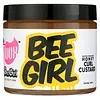What's inside
What's inside
 Key Ingredients
Key Ingredients

 Benefits
Benefits

 Concerns
Concerns

 Ingredients Side-by-side
Ingredients Side-by-side

Water
Skin ConditioningPvp
Emulsion StabilisingArgania Spinosa Kernel Oil
EmollientHistidine
HumectantPanthenyl Ethyl Ether
Panthenol
Skin ConditioningChitosan
Lactic Acid
BufferingPEG-40 Hydrogenated Castor Oil
EmulsifyingParfum
MaskingPolysorbate 80
EmulsifyingPEG-60 Almond Glycerides
EmulsifyingPolysorbate 20
EmulsifyingPhenoxyethanol
PreservativeDisodium EDTA
Ethylhexylglycerin
Skin ConditioningWater
Skin ConditioningPropanediol
SolventMaltodextrin/Vp Copolymer
Pvp
Emulsion StabilisingPolysorbate 20
EmulsifyingAminomethyl Propanol
BufferingAcrylates Copolymer
Aloe Barbadensis Leaf Juice
Skin ConditioningHydroxypropyltrimonium Honey
Keratin Amino Acids
Skin ConditioningSilk Amino Acids
HumectantPhenoxyethanol
PreservativeCarbomer
Emulsion StabilisingSorbitol
HumectantEthylhexylglycerin
Skin ConditioningSodium Lauryl Sulfate
CleansingSodium Hyaluronate
HumectantTocopheryl Acetate
AntioxidantHoney
HumectantPanthenol
Skin ConditioningAcrylates/C10-30 Alkyl Acrylate Crosspolymer
Emulsion StabilisingAscorbic Acid
AntioxidantButylene Glycol
HumectantSorbic Acid
PreservativeCoumarin
PerfumingCaramel
Cosmetic ColorantParfum
MaskingWater, Propanediol, Maltodextrin/Vp Copolymer, Pvp, Polysorbate 20, Aminomethyl Propanol, Acrylates Copolymer, Aloe Barbadensis Leaf Juice, Hydroxypropyltrimonium Honey, Keratin Amino Acids, Silk Amino Acids, Phenoxyethanol, Carbomer, Sorbitol, Ethylhexylglycerin, Sodium Lauryl Sulfate, Sodium Hyaluronate, Tocopheryl Acetate, Honey, Panthenol, Acrylates/C10-30 Alkyl Acrylate Crosspolymer, Ascorbic Acid, Butylene Glycol, Sorbic Acid, Coumarin, Caramel, Parfum
Ingredients Explained
These ingredients are found in both products.
Ingredients higher up in an ingredient list are typically present in a larger amount.
Ethylhexylglycerin (we can't pronounce this either) is commonly used as a preservative and skin softener. It is derived from glyceryl.
You might see Ethylhexylglycerin often paired with other preservatives such as phenoxyethanol. Ethylhexylglycerin has been found to increase the effectiveness of these other preservatives.
Panthenol is a common ingredient that helps hydrate and soothe the skin. It is found naturally in our skin and hair.
There are two forms of panthenol: D and L.
D-panthenol is also known as dexpanthenol. Most cosmetics use dexpanthenol or a mixture of D and L-panthenol.
Panthenol is famous due to its ability to go deeper into the skin's layers. Using this ingredient has numerous pros (and no cons):
Like hyaluronic acid, panthenol is a humectant. Humectants are able to bind and hold large amounts of water to keep skin hydrated.
This ingredient works well for wound healing. It works by increasing tissue in the wound and helps close open wounds.
Once oxidized, panthenol converts to pantothenic acid. Panthothenic acid is found in all living cells.
This ingredient is also referred to as pro-vitamin B5.
Learn more about PanthenolParfum is a catch-all term for an ingredient or more that is used to give a scent to products.
Also called "fragrance", this ingredient can be a blend of hundreds of chemicals or plant oils. This means every product with "fragrance" or "parfum" in the ingredients list is a different mixture.
For instance, Habanolide is a proprietary trade name for a specific aroma chemical. When used as a fragrance ingredient in cosmetics, most aroma chemicals fall under the broad labeling category of “FRAGRANCE” or “PARFUM” according to EU and US regulations.
The term 'parfum' or 'fragrance' is not regulated in many countries. In many cases, it is up to the brand to define this term.
For instance, many brands choose to label themselves as "fragrance-free" because they are not using synthetic fragrances. However, their products may still contain ingredients such as essential oils that are considered a fragrance by INCI standards.
One example is Calendula flower extract. Calendula is an essential oil that still imparts a scent or 'fragrance'.
Depending on the blend, the ingredients in the mixture can cause allergies and sensitivities on the skin. Some ingredients that are known EU allergens include linalool and citronellol.
Parfum can also be used to mask or cover an unpleasant scent.
The bottom line is: not all fragrances/parfum/ingredients are created equally. If you are worried about fragrances, we recommend taking a closer look at an ingredient. And of course, we always recommend speaking with a professional.
Learn more about ParfumPhenoxyethanol is a preservative that has germicide, antimicrobial, and aromatic properties. Studies show that phenoxyethanol can prevent microbial growth. By itself, it has a scent that is similar to that of a rose.
It's often used in formulations along with Caprylyl Glycol to preserve the shelf life of products.
Polysorbate 20 is made by combining ethoxylation of sorbitan, ethylene oxide, and lauric acid. It is a mild cleansing agent, surfactant, and emulsifier.
As a surfactant, it helps collect dirt and oils for washing. Emulsifiers prevent oils and water from separating.
Polysorbate 20 also adds scent to a product. Since it is made using sorbitol, it has a sweet scent. Sorbitol can also be found in fruits such as apples and peaches.
The lauric acid used to create Polysorbate 20 is often derived from coconuts.
Polysorbate 20 may not be fungal acne safe.
Learn more about Polysorbate 20Pvp is a water-soluble synthetic polymer and common hairstyling ingredient. It is a film-forming ingredient and used to "hold" specific shapes of hair.
Pvp is less effective in high-humidity. It tends to draw moisture, but this moisture dismantles the structure and "hold".
Water. It's the most common cosmetic ingredient of all. You'll usually see it at the top of ingredient lists, meaning that it makes up the largest part of the product.
So why is it so popular? Water most often acts as a solvent - this means that it helps dissolve other ingredients into the formulation.
You'll also recognize water as that liquid we all need to stay alive. If you see this, drink a glass of water. Stay hydrated!
Learn more about Water